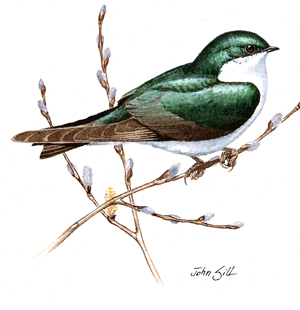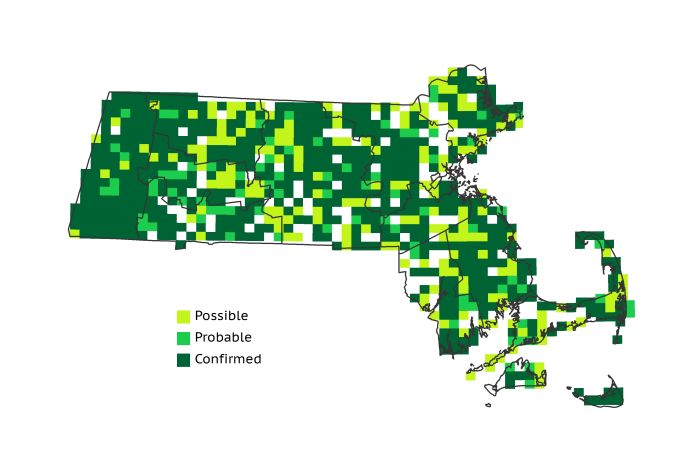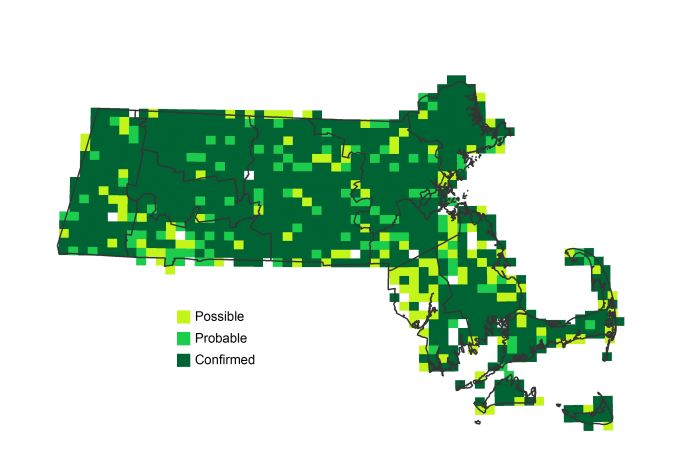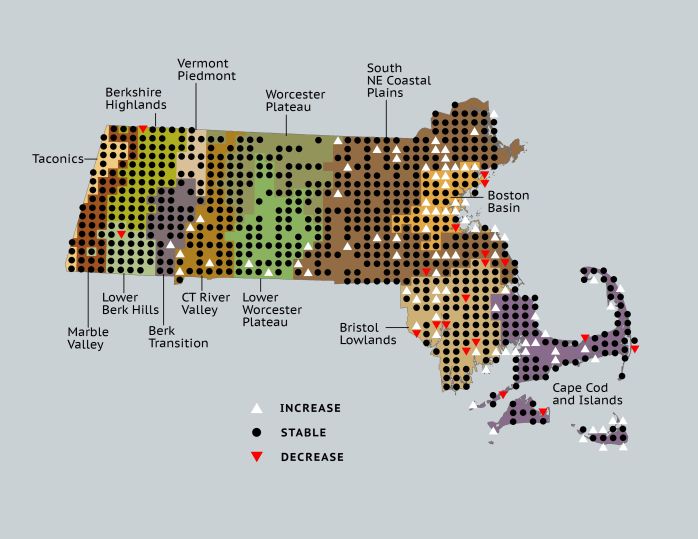Find a Bird
Tree Swallow
Tachycineta bicolor

Nearly ubiquitous and likely increasing
“The twittering of swallows is in the air, reminding me of water.” – Henry David Thoreau, Journal
The liquid twittering of Tree Swallows as they wheel and swoop in pursuit of flying insects has charmed birders from Thoreau’s time to today. Like Purple Martins, Tree Swallows have benefited from nest boxes erected by humans, although they are not as dependent on such charity. Rather, they continue to nest throughout the state wherever suitable nesting cavities exist adjacent to wet, grassy areas over which to forage. Their greater tolerance for colder weather may have allowed Tree Swallows to prosper in regions where Purple Martins cannot.
Historic Status
The Tree, or White-bellied Swallow as it was once known, was seen in greater numbers in the eastern half of Massachusetts than the western half in the middle of the nineteenth century (Peabody 1839). They were long a herald of warmer weather, but were understood to retreat southward if temperatures cooled (Forbush 1929). “As our ancestors long since discovered this fact in relation to their swallows,” wrote nineteenth century ornithologist Henry Davis Minot, “they have handed down to us the wise proverb that ‘one swallow does not make a summer.’” (Minot 1877) Reports from the early 1800s mention their willingness to take to human-made nesting boxes (Peabody 1839, Audubon 1840). Tree Swallows lived a charmed life in Massachusetts until the arrival and eventual spread of House Sparrows in the latter half of the nineteenth century, but they have always been an adaptable species.
Atlas 1 Distribution
Meadows filled with flood-killed trees resulting from the activity of industrious beavers ensured that Tree Swallows had suitable breeding habitat in Atlas 1. The westernmost reaches of the Commonwealth, where beaver activity was most pronounced, had a nearly unbroken distribution of Tree Swallows. Even though the Connecticut River Valley had plenty of available farmland for nesting, the region only posted a relatively unimpressive 84% occupancy, possibly due to the negative impacts of agricultural pesticides. Tree Swallows were still widespread breeders in the rest of the state, though they did not achieve the near-total occupancy seen in the far western regions. The Boston Basin, dominated as it was by development and regenerating forest, had the lowest proportion of occupied blocks of any region (63%).
Atlas 2 Distribution and Change
Massachusetts Atlas workers in the early years of the twenty-first century confirmed the presence of Tree Swallows in 965 blocks, or 93% of the state. That figure was up 10% from the Atlas 1 occupancy total. Across the state Tree Swallows vacated only 19 blocks but occupied 89 new ones. They even found places to live in the still-developing Boston Basin, increasing from 63% occupancy to 86% overall. Tree Swallows showed increases in all but two ecoregions, the Berkshire Highlands and the Lower Berkshire Hills. In spite of a decline reflected in the Breeding Bird Survey, in western Massachusetts Tree Swallows only vacated single blocks.
Atlas 1 Map

Atlas 2 Map

Atlas Change Map

Ecoregion Data
Atlas 1 | Atlas 2 | Change | ||||||
Ecoregion | # Blocks | % Blocks | % of Range | # Blocks | % Blocks | % of Range | Change in # Blocks | Change in % Blocks |
Taconic Mountains | 15 | 93.8 | 1.9 | 21 | 84.0 | 2.2 | 0 | 0.0 |
Marble Valleys/Housatonic Valley | 39 | 100.0 | 4.8 | 39 | 100.0 | 4.0 | 0 | 0.0 |
Berkshire Highlands | 55 | 100.0 | 6.8 | 54 | 98.2 | 5.6 | -1 | -1.9 |
Lower Berkshire Hills | 27 | 96.4 | 3.3 | 28 | 90.3 | 2.9 | -1 | -3.7 |
Vermont Piedmont | 14 | 82.4 | 1.7 | 17 | 100.0 | 1.8 | 0 | 0.0 |
Berkshire Transition | 34 | 89.5 | 4.2 | 39 | 97.5 | 4.0 | 1 | 3.2 |
Connecticut River Valley | 47 | 83.9 | 5.8 | 62 | 95.4 | 6.4 | 5 | 10.4 |
Worcester Plateau | 74 | 94.9 | 9.2 | 87 | 98.9 | 9.0 | 1 | 2.1 |
Lower Worcester Plateau | 61 | 82.4 | 7.6 | 77 | 96.3 | 8.0 | 3 | 5.6 |
S. New England Coastal Plains and Hills | 224 | 83.0 | 27.8 | 274 | 96.8 | 28.4 | 25 | 11.1 |
Boston Basin | 35 | 62.5 | 4.3 | 48 | 85.7 | 5.0 | 12 | 21.8 |
Bristol and Narragansett Lowlands | 86 | 81.1 | 10.7 | 96 | 84.2 | 9.9 | 6 | 5.9 |
Cape Cod and Islands | 96 | 70.6 | 11.9 | 123 | 85.4 | 12.7 | 19 | 15.8 |
Statewide Total | 807 | 83.3 | 100.0 | 965 | 93.1 | 100.0 | 70 | 8.4 |
Notes
The Tree Swallow shows a significant decreasing Breeding Bird Survey trend in the Eastern US overall.



